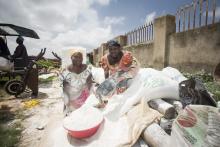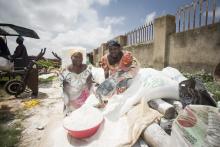The war in Ukraine is now in its seventh month. The fallout—humanitarian, economic and environmental—continues to grow. Its costs are being felt not only within Ukraine but around the world as well, where they are in turn compounding other conflicts and emergencies.
In a new brief, UN Women explores the interrelated crises being driven and exacerbated by the war. Here are 4 key things to know:
Ukraine and the food and fuel crisis: 4 things to know
1. The war in Ukraine is driving food and energy crises globally.
Global food and energy markets are feeling the strain of the war—which means people around the world are feeling it, too.
Both major producers of staple food items, Russia and Ukraine provide 90 per cent of the wheat supply in Armenia, Azerbaijan, Eritrea, Georgia, Mongolia and Somalia. Ukraine is also a major source of wheat for the World Food Programme, which provides food assistance to 115.5 million people in more than 120 countries. And Russia is one of the world’s top three crude oil producers, as well as the second largest producer—and largest exporter—of natural gas.
As the war disrupts production and export processes, these essential commodities are becoming less and less available. Global access to oil and gas has been significantly reduced. Much of the world’s wheat, corn and barley remains in Ukraine and Russia. An even larger portion of the global fertilizer supply—especially crucial for agriculture in soil-depleted countries—remains in Russia and Belarus. The Black Sea Grain Initiative, which has allowed Ukrainian grain exports to resume as of 1 August, is expected to provide some relief.
Nevertheless, these shortages are driving record price hikes. The cost of food has risen by 50 per cent since the start of 2022.Crude oil prices—currently up 33 per cent—are projected to rise above 50 per cent by the end of the year. Fuel transport costs, one of the major causes of inflation in Africa in 2021, have further increased since the start of the war.
Soaring prices are contributing to a global cost-of-living crisis, the impacts of which are falling disproportionately on developing countries. Communities across Africa, Asia, Latin America and the Middle East have been hit hard, with already vulnerable households paying the highest price.
2. Women and girls are being impacted more—and differently.
Systemic inequality makes women more vulnerable to crises. Both within Ukraine and globally, shortages and price hikes are leaving women and girls behind—and putting them in increasing danger.
Even before the war, women’s access to food and energy was more precarious than men’s. The global gender gap in food insecurity, which sat at 1.7 per cent in 2019, rose to over 4 per cent in 2021. And around the world, women and girls are disproportionately affected by energy poverty.
In Ukraine, women-headed households were already more likely to be food insecure. With less access to resources like land and credit as well as to formal employment, and with gender gaps in pay and pensions at 22 per cent and 32 per cent respectively, Ukrainian women have less to fall back on in times of crisis.
Food insecurity and energy poverty drive gender inequality in other areas, including health, education, domestic work and more. In Ukraine and around the world, the ripple effects of the war are furthering existing disparities and exacerbating threats to women and girls’ wellbeing.
Gender-based violence—intensified by both conflict and food insecurity—is on the rise. Domestic violence, sexual exploitation and trafficking, and other forms of violence against women and girls are increasing in Ukraine as well as in other conflict-affected areas, where the diversion of resources and attention have created heightened risk.
Child marriage rates, already significantly elevated due to COVID-19, are expected to rise further. This is common in conflict-affected areas, with rates increasing up to 20 per cent as families resort to desperate measures. Girls are also at heightened risk of leaving school: in Ethiopia, Kenya and Somalia, the number of children at risk of dropping out has increased from 1 million to 3.3 million over three months.
Women and girls are also going hungrier. When there’s not enough food to go around, women typically pay the highest price—cutting down their own intake to save food for other members of the household. This trend is visible in Ukraine and across other conflict-affected areas, driving worsening malnutrition and anaemia among women.
Heightened domestic workloads, too, are falling disproportionately on women. It takes more time and effort to obtain food and fuel when they’re scarce—an added burden that exacerbates existing inequalities at home.
In Ukraine and elsewhere, intersecting forms of discrimination compound gender inequality, putting already vulnerable groups at even greater risk.
3. It’s (past) time to rethink our global food and energy systems.
As the war in Ukraine compounds with other crises, its impacts are revealing major weaknesses in global food and energy systems.
Food insecurity was already on the rise before the outbreak of the war, with an estimated 44 million people at the brink of famine due to COVID-19, climate change and conflict. In total, roughly 345 million people across 82 countries are facing acute food insecurity or high risk of it in 2022—almost 200 million more than before the pandemic.
Energy poverty also remains pervasive, with much recent progress wiped out during COVID-19. As of 2020, 733 million people still lacked access to electricity. A whopping 2.4 billion people lack access to clean cooking, a driver of household air pollution that causes 3.2 premature deaths per year, mostly among women and children. And roughly 1 billion people are served by healthcare facilities that don’t have reliable electricity—meaning price hikes and service disruptions can compromise medical care.
The vulnerability of global food and energy systems is due in large part to our reliance on fossil fuels. As long as energy security is tied to oil and gas, it will remain susceptible to market volatility and price shocks: many who lost energy access during COVID-19 simply couldn’t afford to pay. And the role of fossil fuels in agricultural production and distribution—for example, natural gas’s role in the production of nitrogen-based fertilizers—means that oil price shocks also drive increased volatility in food prices.
Against the backdrop of worsening climate and environmental crises, the war in Ukraine underscores the urgency of transitioning away from fossil fuels. Yet, soaring oil and gas prices may ultimately drive increased investment in fossil fuel-based energy: windfall profits to the fossil fuel industry, will make change more difficult. Without intervention, the world may see a reversal of decarbonization—on which progress is already moving too slowly.
We need sustainable, gender-responsive solutions.
Gender equality must be a key consideration in response, recovery and peace-building efforts in Ukraine—but so far, most have failed to incorporate it at all. The same is true for other crises, such as COVID-19 and climate change, where gender-responsive action has been insufficient at best and non-existent at worst.
Adopting sustainable alternatives to fossil fuel-based energy and agriculture is a crucial step toward global gender equality. It will help to close gender gaps in food and energy security, reduce deaths via air pollution and reduce unpaid care and domestic workloads. It will also mean new green jobs for women and a potential increase in the productivity of women’s small-scale farming.
This kind of systemic change requires significant resources. Windfall taxes on oil and gas companies, as well as the elimination of fossil fuel subsidies—on which the world spends an annual USD$423 billion—can help to reallocate funds away from the fossil fuel industry and toward the creation of new gender-responsive, sustainable systems.
Above all, women must be included in all decision-making processes. It is only with women’s participation and leadership that the world will find solutions to the many crises it faces.

